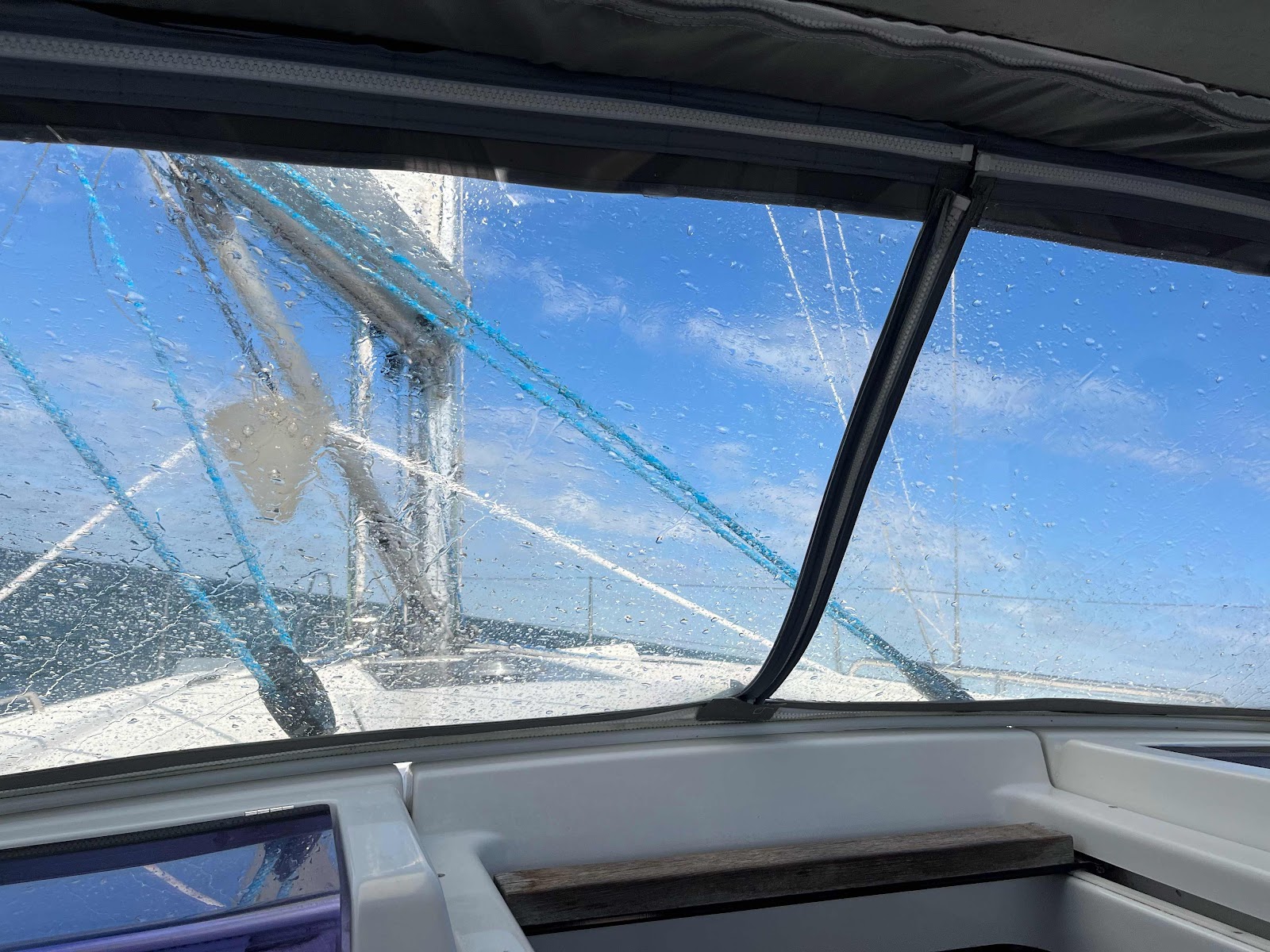We left Cape Charles just after 5:30 Sunday morning with a goal of reaching the Homer Smith Docks—in Beaufort, NC—before they closed today (Monday) afternoon. We motored down the bay for about 45 minutes, waiting for there to be enough light in the sky to see what we were doing when raising the mainsail. We passed over the bridge tunnel, leaving the Bay, at 8:00 am and had a pleasant sail with just the mainsail, averaging over seven knots with wind of 15-18 knots. In the afternoon the wind dropped to below 15 knots so we unfurled the jib and sailed with both the jib and main.

Sunrise in the Chesapeake Bay.

The enclosure keeps us relatively warm but it isn’t airtight. When I feel the cool air coming in I am reminded of the many times I heard my grandmother say, “I feel a draft.” We use old towels to cover up some of the gaps.

Passing over the northern tunnel of the Chesapeake Bay Bridge Tunnel.

Splashes from some of the waves.
As we approached Cape Hatteras shortly before midnight the wind increased to over 20 knots and the boat rounded up. It was time to furl the jib. It happened not long before we were scheduled to change watches. George was in the cabin but heard the commotion when we rounded up and came into the cockpit to help. We sorted everything out and I went to bed. After George rounded Cape Hatteras we were sailing dead downwind. He had to watch the apparent wind angle carefully to avoid an unplanned gybe, which might happen when a wave pushes the boat further downwind. By the same token, a wave could push the boat too high. If that happens at the same time as a gust of wind, the boat can round up. The autopilot does its best to adjust but this morning it blew a fuse and quit working. At the same moment the very loud bilge alarm began to blare. Since the autopilot wasn’t working George had to steer by hand and couldn’t leave the helm. I was in the cabin and it took me a few minutes to come up into the cockpit to help. Once I got there I took over at the helm to hand steer the boat while George investigated the bilge (finding only a tiny amount of water), shut off the alarm, and replaced the autopilot fuse. It was an exciting period for two sleep-deprived people.
When we rounded Cape Lookout we were sailing at a higher angle so didn’t have to worry about unplanned gybes. The waves were larger, though, and more on the beam. Several splashed over the boat. We were very grateful to have the enclosure to keep us from taking cold, salt water showers.
The wind did not let up even as we approached Beaufort. We were both nervous about getting into our assigned slip which is exposed to the NE wind. In addition, the wind would be pushing us off of the dock. We talked about anchoring somewhere and waiting for the wind to die down, but in the end we decided to at least try to get into the slip. After I passed the end of the dock I took a very sharp turn and aimed right for the dock in our slip. I came in at a higher speed than usual—“coming in hot!”—to reduce the chance that the wind would grab the boat and push it away from the dock. The dock master, Dan, was there to grab the lines and it all went as planned. Phew! What a relief!
Since leaving Cape Charles we traveled 226 nautical miles in 32 hours, averaging 7.1 knots. Since leaving home we have traveled 352 nautical miles.
Sunrise in the Chesapeake Bay.
The enclosure keeps us relatively warm but it isn’t airtight. When I feel the cool air coming in I am reminded of the many times I heard my grandmother say, “I feel a draft.” We use old towels to cover up some of the gaps.
Passing over the northern tunnel of the Chesapeake Bay Bridge Tunnel.
Splashes from some of the waves.
It’s a good thing you are both experienced sailors, there is so much to know.
ReplyDeleteYes, there is and we are still learning.
Delete